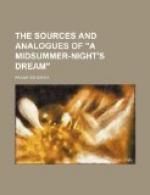He proceeds to narrate how all the fairies but one were invited to his birth, and that one, in anger, said that when he was three years old he should cease to grow; however, she repented immediately and added that he should be “the fairest creature that nature ever formed.” Another fairy endowed him with the power of seeing into the minds of all men; and a third enabled him to go whither he would at a wish. “Moreover, if I will have a castle or a palace at my own device, incontinent it shall be made, and as soon gone again if I list; and what meat or wine that I will wish for, I shall have it incontinent.”
Elsewhere[80] in the romance his handsome equipment and dress are described; his gown, his bow, and above all his horn, “made by four ladies of the fairy,” who endowed it with four gifts; it cured all diseases by its blast, it banished hunger and thirst, it brought joy to the heavy-hearted, and forced any one who heard to come at the wish of its owner.
Horns, in English folk-lore, appear to belong rather to elves than to fairies[81]—the elves that haunt hills, and are known all over Europe; dwarfs, trolls, kobolds, pixies, and so forth. Teutonic witches are called horn-blowers. Again, the fairy-train or fairy-hunt is supposed to carry horns; we have seen it already in Sir Orfeo,[82] and in Thomas of Erceldoune,[83] the fairy-queen bears a horn about her neck.
But this Oberon of Huon of Bordeaux is mortal, and is not pictured as being abnormal in stature, any more than Mider. Shakespeare’s Oberon and Mider are invisible (or can make themselves so), both have supernatural powers, and both are immortal.
The question of the size conventionally attributed to the fairies is of importance, because it shows that a confusion existed between the fays of romance with the elves of folk-superstition. Elves and their numerous counterparts in all European countries and elsewhere—we have just given a list of names which can easily be extended—are above all things small; they also are earth-dwellers, living in hills or underground chambers, and originally, perhaps, were supposed to be mischievous by nature. But even in Shakespeare’s day, it would be impossible to say that fairies were benevolent and elves malevolent; the two kinds and their respective characteristics were already confused.
Robin Goodfellow, the Puck, or Hobgoblin, is however essentially mischievous. In a book contemporary with our play we find:—
“Think me to be one of those Familiares Lares that were rather pleasantly disposed than endued with any hurtful influence, as Hob Thrust, Robin Goodfellow, and suchlike spirits, as they term them, of the buttery, famoused in every old wives’ chronicle for their mad merry pranks."[84]




